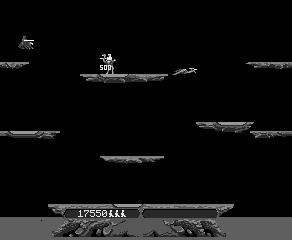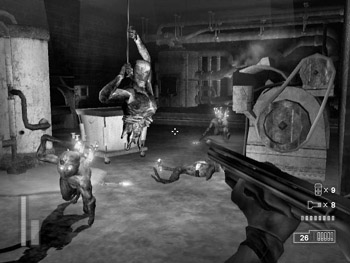Levels in Different Games
Levels in Different Games
The definition of a level varies greatly from game to game. It most commonly refers to the game-world of side-scrollers, first-person shooters, adventures , flight simulators, and role-playing games. These games tend to have distinct areas that are referred to as levels. These areas may be constrained by geographical area (lava world versus ice world), by the amount of content that can be kept in memory at once, or by the amount of gameplay that feels right before players are granted a short reprieve preceding the beginning of the next level. Though many classic arcade games such as Centipede or Space Invaders took place entirely on one level, others such as Pac-Man or Joust offered simple variations on the game-world and game challenges to prolong their gameplay. Thus, the different mazes in Pac-Man constitute its levels. In a campaign- based strategy game such as StarCraft, the levels or scenarios are defined by maps accompanied by objectives players must accomplish, such as defend the Terrans against the Protoss forces in this amount of time. In a racing game, a level would be one of the tracks available in the game. In a sports game, say baseball, the levels would be the different stadiums featured in the game. Here the difference between the various levels is completely aesthetic , since in terms of play mechanics, a baseball game played in Wrigley Field is only subtly different from one played in Yankee Stadium.

Joust made simple changes to its game-world to produce different levels.
Games such as Civilization and SimCity do have levels, but one key difference from the games described above is that the entirety of a player s game takes place on a single level. The base level is also often randomly generated following carefully designed rules, and from there it is largely the user s responsibility to construct the level as she plays. This is why these titles are often referred to as builder games. For these titles, the authorship of the level is almost entirely abdicated to the players.
This chapter deals primarily with games that use pre-built levels that have a major impact on the gameplay. Though sports titles and builder games may have levels, their construction is left up to the artists and players respectively, and therefore is not generally of concern to designers. For games like Doom , Tomb Raider , Super Mario 64 , Maniac Mansion , Pac-Man, StarCraft , and Fallout , however, the design of the levels has everything to do with gameplay and therefore the designer must be intimately involved with their creation.
Level Separation
How a game is broken down into its component levels has a huge impact on the flow of the game. Players often play a game a level at a time. If a parent announces dinner while a child is playing a game, that child is likely to beg to be allowed to just finish this level. In console games, frequently players can only save their game between levels, which places further importance on the end of a level as the completion of a unit of gameplay. A level can function like an act in a play, a chapter in a book, or a movement in a symphony. It gives the audience a chance to see a discrete unit within a larger work, to understand what portion of the work has been completed and how much awaits ahead. Carefully orchestrated levels are set up such that they have a series of tension and release moments to create an emotional curve for the player to experience. When players finally see that the level has ended, they know that they have accomplished a significant amount of gameplay and should feel proud of themselves .
Technical limitations often dictate where the end of a level must occur. Only so many textures, sounds, and level data can fit in memory at once, and when those resources are used up, the gameplay has to stop long enough for different world data to be loaded in. New technologies present the opportunity for more seamless environments. Even on the technically limited PlayStation, the developer Insomniac was able to avoid loading screens entirely in Spyro the Dragon , instead just having Spyro fly into the air for a second (while the necessary data is swapped in) and then having him fly back to earth in the new level. To casual players watching Spyro , the break is much less jarring than seeing a loading screen come up. The Spyro the Dragon levels still have to be divided into sections between these non-loading screens, however, meaning that the gameplay in those levels is still limited to a certain amount of space. A good designer, of course, can take the memory constraints and use them properly to create levels that are fun and challenging to play while also fitting in the space available. Again, the designer must take the limitations of the hardware and embrace them.
Half-Life is another interesting example of level division. Here the team at Valve wanted to create a more seamless experience for players, but were still using the limited Quake technology. Quake had featured thirty or so levels, each of which took a significant amount of time to load. In Quake the levels existed in separate universes from each other; never would a monster chase players from one level to another, never would players return to a previous level. The programmers at Valve came up with a system where, if the levels were small enough, they could be loaded in less than five seconds. They also made modifications so that monsters could track players across the boundaries between maps. The level designers at Valve were able to make their levels very small, much smaller than a standard Quake level, but then created a great quantity of them. The areas between two levels contain identical architecture, such that players can run across the border between two of these levels and, aside from the brief loading message, not even know they had crossed a level boundary. The result is a much more seamless experience for players. Evidently the team still felt the need for story arcs in the game, since text chapter titles appear briefly on the screen at key points during the game. Indeed, these titles work quite nicely as mini-rewards for the players, letting them know they have accomplished a good chunk of gameplay, much like used to be conveyed by a long level load. But since the programming and design teams were able to create a near-seamless level loading system, the design team was able to separate the game into these storytelling units wherever it felt best, instead of where the technology dictated. The ideal for an immersive game like Half-Life, of course, would be to eliminate these load times entirely.
Since Half-Life was released, some games have managed to pull off a completely continuous world, including Jak & Daxter and Dungeon Siege . These games only managed this feat after the investment of a large amount of development time, though the payoff seems to have been worth it.
Level Order
The order in which the levels occur is also important to the overall flow of the game. Perhaps big shoot-out levels should be alternated with more strategic or puzzle-oriented levels. If a game places all of its strategic levels early in the game and then crowds the end with more action-oriented episodes , the game will seem to change midway through, upsetting the balance players have come to expect. At the very least, the designer should know how the order of the levels will affect the flow of gameplay, and should be aware of how moving different levels around will affect it. For example, if a game has thirty levels and six boss monsters, one logical way to place these adversaries in the game would be at the end of the fifth, tenth, fifteenth, twentieth, twenty-fifth, and thirtieth levels. The bosses certainly do not have to be on those precise levels, and each can be shifted slightly forward or backward in the level order without causing any serious problems. If the bosses were placed one each on the last six levels of the game, this would be obviously unbalanced. It would seem strange to players that after twenty-four levels of no-boss-monster gameplay, suddenly they have to fight one every level.
The way the game is broken up into its different levels and the order in which those levels must occur differs from game to game. For a game like Unreal , as with the Doom and Quake series before it, the designers were only instructed to make some cool levels, with little concern for story (since none of these games really had one) or which events should happen before which other events. Some thought was put into at what point certain adversaries would first appear in the game, and hence the earlier levels were more restricted in which creatures they could use. Similarly, of course, the earlier levels had to be easier and the later ones had to be harder. But for the most part, the level designers just tried to make the coolest levels possible, almost working in a vacuum from the other designers. Certainly they would see each other s work and this might inspire them to make their own levels better, but none of the levels really had to match up thematically with the levels that came before or after it, and the lack of a story meant that this did not adversely affect the game.
In games such as Indiana Jones and the Infernal Machine , Knights of the Old Republic -, or The Suffering , however, the story plays a much larger role. In order for the story to work, the levels need to support it. Hence, for a more story-centric game, a great deal of preplanning is done by the game s design and story teams as to which story events need to happen in which levels. In what sorts of environments should those levels take place? What types of adversaries will players fight there? The order in which the levels appear in the game cannot be changed as easily as in Doom , since that would radically change the story as well. In order for the entire game to flow and escalate in difficulty appropriately, the type of gameplay found in each level must be planned ahead of time. The levels do not need to be planned down to minute detail, however, as this is best left to the level designer, who can place the individual encounters, objects, or minor puzzles as they best fit the level. A mini design document explaining what the level has to accomplish in order to function within the game s story will allow the level designer to know exactly what she must include in the level; from there she can fill in the details.

In a game like The Suffering , the story and levels are so tightly interwoven that the levels cannot be reordered and still make any sense.
EAN: 2147483647
Pages: 189